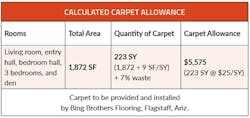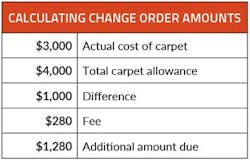The Lowdown on Calculated Allowances
In a construction contract, a calculated allowance is an amount determined by facts, figures, and experience to serve as a placeholder expense for as-yet unspecified items, such as light fixtures or cabinets. An allowance should be reasonable and match, as closely as possible, the quality the owner anticipates for the items it covers. Amounts that are much too high or low can cause problems when selections are actually made. For example, an allowance of $1,000 for floor covering for a 2,000-square-foot home works out to 50 cents per square foot or $4.50 per square yard. Even if you find something at that price, your clients will not be happy.
Define the Circumstances and Parameters
Using that example, here’s how I would calculate a more accurate allowance amount for carpet. First, I would list the rooms to be carpeted, along with the total square footage and a conversion to square yards.
Next, in addition to showing the total allowance price for carpet, I would show the installed cost per square yard.
To ensure that the allowance is reasonable, I use my judgment based on the quality of other finishes the client has chosen. If there’s time, I accompany the client to my floor-covering sub’s showroom. Sometimes they end up making a selection, but even if they don’t choose a particular carpet, I can tell whether they are gravitating toward the $25-per-yard samples or those at $40 per yard, and I can build the cost of that perceived preference into the allowance.
Break It Down
My estimates usually contain 100 to 125 job-cost line item subcategories such as Carpet, Hardwood, Sheet Goods, Tile, etc.—the more “breakdown” the better the estimate. In most of these subcategories, allowances are among up to a dozen detailed line-item amounts. Overhead and profit for the whole subcategory, including allowances, are built into the contract price because all of those line items are summarized into one number for the parent category—“Flooring,” for example, or “Lighting” or “Painting.”
Resolve Allowances With Change Orders
As luck would have it, when the client finally makes a product selection, the cost rarely matches the allowance amount. Whether it’s higher or lower, I handle the difference with a change order.
Following our example, let’s say that instead of choosing carpet at the allowance price of $25 per square yard, the client chooses more expensive $40-per-square-yard goods for the living room and both halls, but less expensive $20-per-square-yard carpet for the three bedrooms and the den. In that situation, I would issue a change order showing both the total installed invoice amount and the original allowance amount as lump sums. The difference would be either refunded to or paid by the owner.
These two adjustments are handled differently, and my contract spells that out. Except for small overages, which I typically let slide, when the client spends more than the allowance amount, my contract states that any “additional expenses” will be billed at cost plus a given percentage of the overage (typically 28 percent). So if, in our carpeting example, the client spends $1,000 more than the allowance, I would issue a change order showing the original allowance amount and the overage plus percentage.
When the client underspends, the change order subtracts the simple difference between the allowance and the actual cost from the contract price. Occasionally customers will ask why no fee or percentage is refunded. My answer really begins before we sign the contract, when I explain that I try to eliminate allowances to avoid the cost and aggravation. Unresolved allowances can affect the schedule and can even require changes to work that’s already been completed. Except for special circumstances, I don’t refund my fee because it compensates for the time I spend helping with the ultimate product selection, writing up the change order, and double-checking how allowance choices affect other work.
My favorite clients are those who have been through a construction project before because they understand exactly what I’m talking about. And they are usually amazed at the level of detail I include and the systematic way in which I approach allowances and change orders. If you adopt some of these ideas, the same will be true for you.

